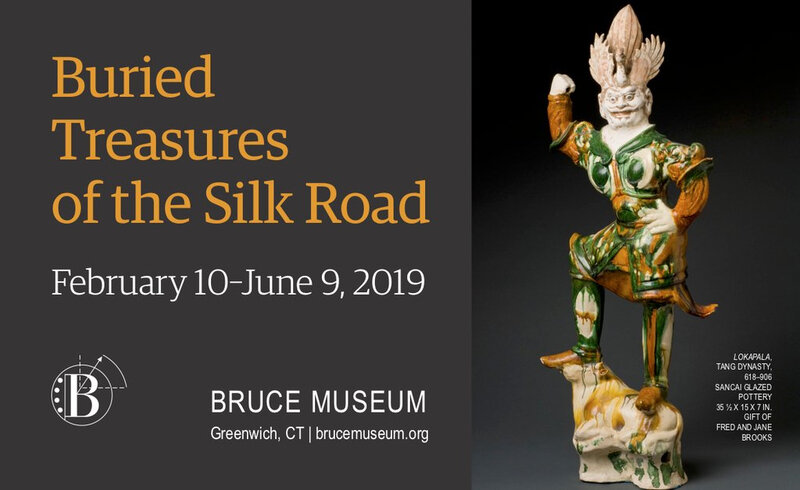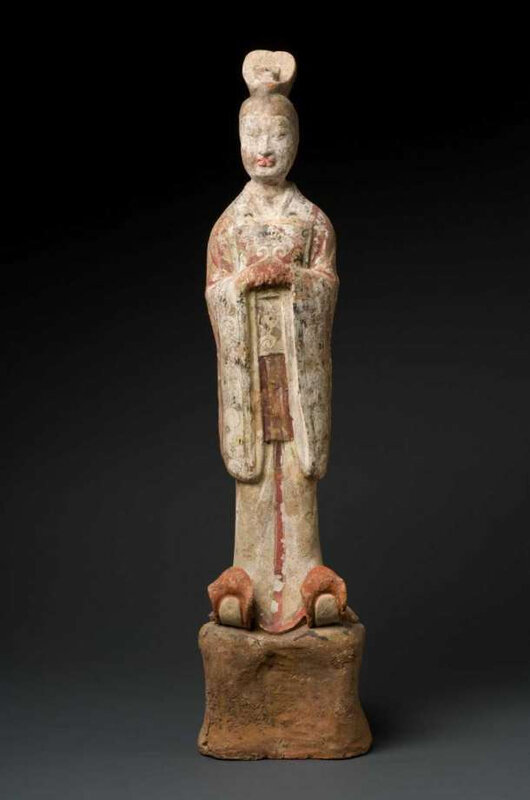Extraordinary collection of Chinese tomb sculpture opens at the Bruce Museum
GREENWICH, CONN.- A new exhibition opened at the Bruce Museum in Greenwich, CT, that showcases the extraordinary collection of Chinese tomb sculpture in the Fred and Jane Brooks Collection of the Bruce Museum. Featuring dozens of rare and delicate terra cotta figurines, painted and glazed ceramics, and other antiquities, Buried Treasures of the Silk Road is on view in the Museum’s Arcade Gallery through June 2, 2019.
During the period of peace and prosperity of the Han Dynasty (206BCE – 220CE), considered the Golden Age of China, emissaries ventured from China into Eurasia. Merchants soon followed, laden with polychrome, patterned silk – a luxury never seen outside of China. In time, these merchants transported other exotic goods, including lapis lazuli and other precious metals, furs, and ivory on the backs of camels, donkeys, and horses to ever more distant markets, extending the range of trading partners along the way.
Lokapala, Tang Dynasty,618-906. Sancai glazed pottery, 35 ½ x 15 x 7 in,Gift of Fred and Jane Brooks, Bruce Museum Collection, 2013.15.01. Photo by Paul Mutino.
Evolving into a network of overland and water routes that stretched thousands of miles across China and Central Asia to Eastern Europe, the Silk Road introduced and formalized the practice of international trade.
Han administrators established military garrisons housed in watch towers along the land route, imposed strict travel and trade regulations, and collected taxes. The invention of paper provided portable, reliable maps and indelible ink trade contracts. Trade centers grew to become bustling, cosmopolitan cities where markets supported a multicultural exchange of ideas, inventions, and commodities. The Han Dynasty maintained control of trade over the Silk Road for four hundred years.
Caravan Camel, Tang Dynasty, 618-906. Sancai glazed pottery, 29½ x 19 x 7 in. Gift of Fred and Jane Brooks. Bruce Museum Collection, 2013.15.03. Photo by Paul Mutino
China's second great empire, the Tang Dynasty (618 CE-906 CE) is considered the Golden Age of Chinese Cosmopolitanism, an era when foreign ideas, products, and religions were welcomed. Tang Emperors reestablished the Han model of control over taxes and tolls along the network of Silk Road markets. Prosperity supported the arts, and multicultural influences created interest in new forms of music, dance, fashion, and artistic expression. Traditional Chinese rites and customs evolved.
During both the Han and Tang dynasties, mortuary rites and customs were important elements of Chinese culture. Wealthy citizens expanded on the tradition of furnishing their massive burial chambers with numerous and elaborate art objects. Grave goods, called mingqi or “spirit goods,” indicated the status of the person on earth and were interred for use in the afterlife. The materials and stylistic elements of grave goods reflect the way artists and craftsmen embraced the multicultural influences that entered China via the Silk Road.
Camel, Tang Dynasty, 618-906. Sancai with blue glaze pottery, 15 x 12 ½ x 6 in., Gift of Fred and Jane Brooks, Bruce Museum Collection, 2013.15.04. Photo by Paul Mutino.
Buried Treasures celebrates the artistic achievements of anonymous Chinese artists supported by the riches earned on the Silk Road. The exhibition also features art objects from the Museum’s permanent collection exchanged on the Silk Road.
“When we in the Western world think of ancient art, we tend to focus on Greek and Roman culture,” says Fred Brooks, a longtime Greenwich resident who, with his wife Jane, has spent decades collecting Chinese ceramics, notably ancient tomb art. “But all through that period of time, the Han Dynasty also had a great empire, and art was central to their lives – and more important to the leaders, their afterlife.”
Courtier, Tang Dynasty, 618-906. Painted terra cotta, 31½ x 8 x 8 in. Gift of Fred and Jane Brooks. Bruce Museum Collection, 2013.15.02. Photo by Paul Mutino.
In light of the current Chinese government’s efforts to restore and revive this ancient trade route, this exhibition has a special topicality, says Kirsten Reinhardt, Museum Registrar and the organizer of Buried Treasures.
“For more than one thousand years, from 206 BCE until 907 CE, Chinese Emperors dealt with the same issues that are in the news today: international trade treaties, tariffs, border walls, nationalism, and immigration,” says Reinhardt. “Through military strength, diplomacy, and technological advancements China developed, controlled, and prospered from commerce on the Silk Road. Everything old is new again."
Yellow-painted Camel, Tang Dynasty, Gift of Fred and Jane Brooks. Bruce Museum Collection, 2013.15.05.
Bull, Tang Dynasty, 618-906. Painted terra cotta. Gift of Fred and Jane Brooks. Bruce Museum Collection.

/https%3A%2F%2Fprofilepics.canalblog.com%2Fprofilepics%2F1%2F0%2F100183.jpg)
/https%3A%2F%2Fstorage.canalblog.com%2F03%2F02%2F119589%2F96711876_o.jpg)
/https%3A%2F%2Fstorage.canalblog.com%2F11%2F31%2F119589%2F94773502_o.jpg)
/https%3A%2F%2Fstorage.canalblog.com%2F20%2F83%2F119589%2F94772815_o.jpg)
/https%3A%2F%2Fstorage.canalblog.com%2F26%2F72%2F119589%2F75604929_o.jpg)
/https%3A%2F%2Fstorage.canalblog.com%2F59%2F60%2F119589%2F26458628_o.jpg)









/http%3A%2F%2Fstorage.canalblog.com%2F19%2F39%2F119589%2F129703955_o.jpg)
/http%3A%2F%2Fstorage.canalblog.com%2F66%2F44%2F119589%2F128744406_o.jpg)
/http%3A%2F%2Fstorage.canalblog.com%2F95%2F62%2F119589%2F128744349_o.jpg)
/http%3A%2F%2Fstorage.canalblog.com%2F85%2F98%2F119589%2F128458836_o.jpg)